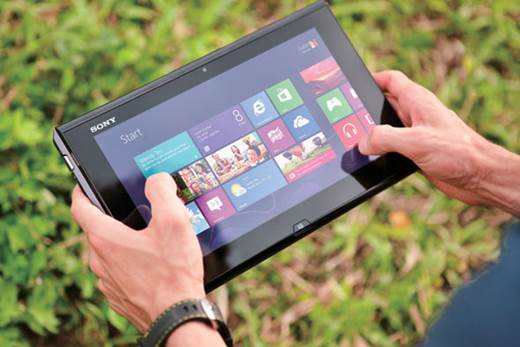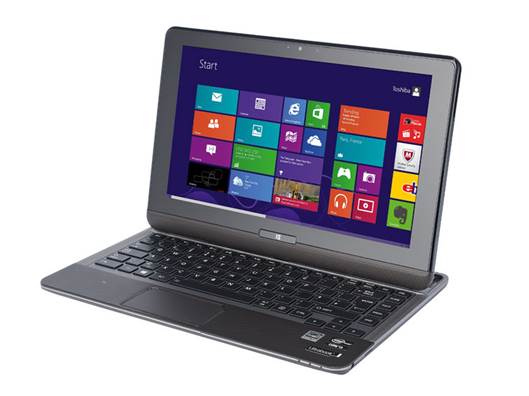Sony VAIO Duo 11
A stylish, well-built machine with
too many compromises to challenge the best hybrids
Price: $1,862
Ratings: 4/6

The
Sony VAIO Duo 11 fuses the DNA of an Ultrabook with an 11.6in Full HD tablet
As hybrid hinge mechanisms go, the Duo 11’s
has to be the most complex. Pull the lip at the rear of the screen upwards, and
it swings quickly up in one smooth motion to reveal a compact keyboard
underneath. It looks as good as it feels, and the matte-carbon case and metal
keyboard surround are extremely sturdy. We had to try very hard to make the
chassis flex at all.
Like the Asus Taichi, the VAIO includes a
stylus and an N-trig digitizer, and interchangeable nibs allow you to choose
between a soft and firm feel. The Duo 11 doesn’t lack in connectivity, either.
There are two USB 3 ports, full-sized HDMI and D-SUB outputs, a card reader and
Gigabit Ethernet socket, plus dual-band 802.11n wireless, Bluetooth 4 and NFC
on the inside.
It’s a beast of a performer. The 1.9GHz
Core i7-3517U zipped through our benchmarks to a table-topping score of 0.71,
and the VAIO’s light-use battery life result of 7hrs 6mins is the best of any
hybrid on test.

Colours
are produced accurately throughout, and the IPS panel ensures that those vivid
hues remain true from almost any viewing angle
The screen’s Full HD resolution and 11.6in
diagonal matches the sharpest screens here for pixel count, and a measured
brightness of 451cd/m2 and contrast ratio of 868:1 mean the panel is
adept at reproducing both bright and dark tones. Colors are produced accurately
throughout, and the IPS panel ensures that those vivid hues remain true from
almost any viewing angle.
Start using the VAIO, however and serious
problems start to appear. To save space, Sony has opted for a track point
instead of a touchpad, which is fiddly to use. The keyboard is better, but the
close proximity of the trackpoint’s buttons to the spacebar results in lots of
accidental clicks. The lack of a Wrist Rest makes it difficult to find a
comfortable typing position with the VAIO balanced on your lap. You can’t
adjust the screen angle, and the 1.28kg weight ensures it’s too heavy for
prolonged use as a tablet.
We like the slick design, good build quality
and high-end specification, but the Duo 11 makes too many compromises. Coupled
with a high price of $2,233 inc VAT, there’s little reason, beyond brand
snobbery, to choose this hybrid.
Toshiba Satellite U920t
An uninspiring device, despite a
flexible hinge design and a decent quality display
Price: $1,105
Ratings: 4/6

Toshiba
is the latest to join in the fun with its 12.5in Satellite U920t
Toshiba’s Satellite U920t uses a similar
hinge mechanism to the Sony VAIO. The screen sits on top of the keyboard in
tablet mode, slides up on a track, and then flips out into laptop position.
This is cumbersome compared with the Sony’s
whippet-like hinge, and the complicated engineering means the laptop is
heavier, too but there are practical benefits. The angle of the screen is
adjustable, and it leaves more room on the base, allowing for both a keyboard
and touchpad. The former has a sensible layout and a comfortable typing action,
and, while the small trackpad doesn’t support Windows 8’s edge-swipe gestures,
it’s smooth and responsive.
The dual-core Intel Core i3-3217U processor
and 4GB of RAM returned a mediocre score of 0.51 in our benchmarks, but it’s
snappy in use: Windows 8’s Start screen responds smoothly to the touch, and
browsing the web is fast and fluid. That’s partly due to the 128GB Samsung SSD,
which delivered sequential read and write tests at 456MB/sec and 249MB/sec only
a touch behind the Dell XPS 12.

The
larger size of the U920t also means there’s plenty of room for a keyboard and
touchpad
The screen’s 1,366x768 resolution doesn’t
compete with the 1080p screens found on rivals, but quality is acceptable:
measuring it with a colorimeter saw a top brightness level of 320cd/m2
and a contrast ratio of 890:1, and the viewing angles of the IPS panel are excellent.
Sadly, the novel design leaves it paying
the price in other areas. The light-use battery life score of 5hrs 40mins is
disappointing, and there’s room for only two USB 3 ports and an SD card reader;
Ethernet is missing entirely.
Toshiba has put together a flexible, usable
machine in the Satellite U920t, but it isn’t without problems, with a
cumbersome mechanism to transform between the two modes and below par battery
life. The price is attractive, but the more elegant Yoga 13 doesn’t cost much more,
and it’s far more competent overall.